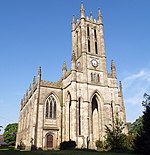Bury Golf Club
1890 establishments in EnglandGolf clubs and courses designed by Alister MacKenzieGolf clubs and courses designed by Harry ColtGolf clubs and courses in Greater ManchesterOrganisations based in Bury, Greater Manchester ... and 4 more
Sport in Bury, Greater ManchesterSport in the Metropolitan Borough of BurySports venues completed in 1890Use British English from February 2023

Bury Golf Club, is a private golf course and club in Unsworth, Bury, designed by Alister MacKenzie, Charles Hugh Alison, and Harry Shapland Colt. The club was originally located at a course in Redvales, Bury, before moving to its current Unsworth location in 1922. The current course is eighteen-holes in length, and sits east of the clubhouse at Unsworth Hall. Notable players include Harry Vardon, Henry James, Sandy Herd, and Alister MacKenzie.
Excerpt from the Wikipedia article Bury Golf Club (License: CC BY-SA 3.0, Authors, Images).Bury Golf Club
94BUR,
Geographical coordinates (GPS) Address Nearby Places Show on map
Geographical coordinates (GPS)
| Latitude | Longitude |
|---|---|
| N 53.565149 ° | E -2.288909 ° |
Address
94BUR
94BUR
BL9 9TP , Blackford Bridge
England, United Kingdom
Open on Google Maps








